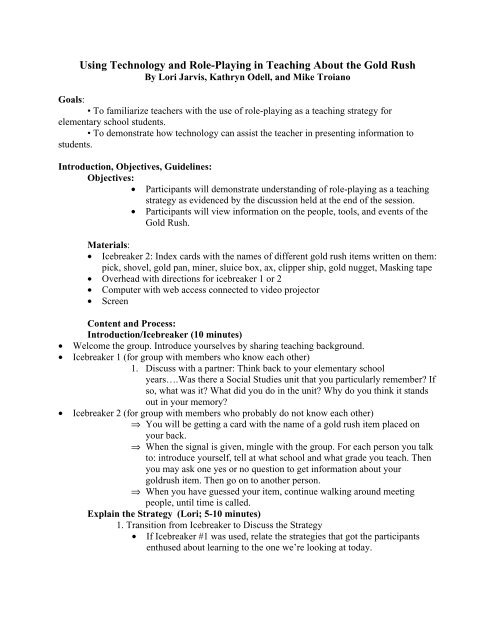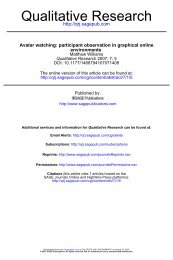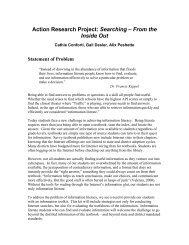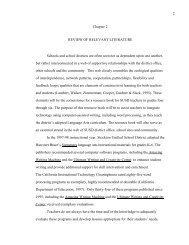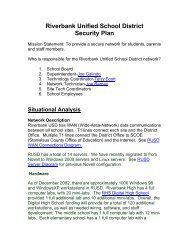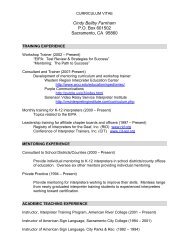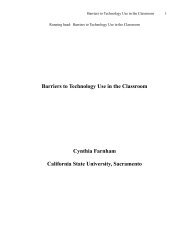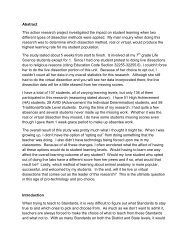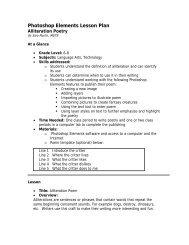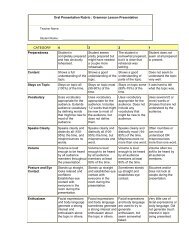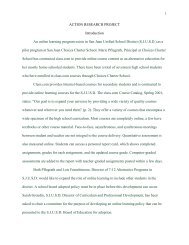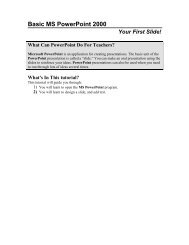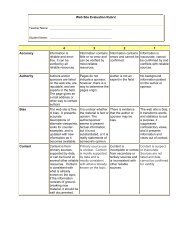Facilitator Guide (pdf) - iMET
Facilitator Guide (pdf) - iMET
Facilitator Guide (pdf) - iMET
You also want an ePaper? Increase the reach of your titles
YUMPU automatically turns print PDFs into web optimized ePapers that Google loves.
• If Icebreaker #2 was used, transition to the next segment by by asking thegroup how they did on discovering their Gold Rush items? Acceptcomments, then move on to step 2 below.2. Explain that the Gold Rush was an exciting time in California history, but thattoo often the Social Studies text turns this great historical period into a boringseries of lessons. Why not instead use technology, along with the strategy ofrole-playing to enliven your Social Studies curriculum? (The following pointswill be projected to the group as they are presented.)3. Presentation• What is role-playing: According to Joyce and Weil (2000), roleplayingis a strategy that fits within the social family of models. Thesestrategies emphasize the social nature of learning and see cooperativebehavior as stimulating students both socially and intellectually• Some advantages of role-playing: student interest in the topic is raised;increased involvement on the part of the students means increasedlearning; and it teaches empathy and understanding of differentperspectives• In role-playing the student s representing and experiencing a characterknown in everyday life; Gold Rush characters include James Marshall,John Sutter, John Studebaker, Lotta Crabtree, and Phoebe AppertonHearst.The use of role-playing emphasizes personal concerns, problems,behavior, and active participation.• One possible use of role-playing might be to introduce a topic, usingthe students' background knowledge (schema) to introduce and interestthem in a new unit of study. But probably more often, role-playing isused as a strategy in which students use their background knowledgein addition to acquiring new information about the character in orderto better play the role.• Role-playing activities can be divided into four stages:1. preparation and explanation of activity by teacher2. student preparation of activity3. role-playing4. the discussion or debriefing after role-playingDemonstrate the Website (15 minutes) Do a model test drive of the site using the videoprojector to display while the site is viewed by the group.1. Give a brief tour of the site navigation (Lori).2. Demonstrate the three towns of the site (Vito: Coloma; Kathryn: Columbia;Lori: Placerville.)Give participants time as available to go to a computer and do their own test drive of thesite.3. Call everyone back to the tables, for a brief follow-up discussion.Closing (Vito; 10 minutes)• Questions?• Did you see Role-Playing used in any of the activites on the website? How?
• How might this strategy be used at a different grade level? Discuss with a partner; then sharewhole group.• Thank everyone for their attention.Assessment (This actually takes place during the closing.)• Check for understanding of strategy in group discussion.⇒ Did the participants recognize the role-playing activities in the website?⇒ Were participants able to suggest ways the strategy might be used at adifferent grade level?
Icebreaker ActivityDiscuss with a partner: Think backto your elementary school years….• Was there a Social Studies unit thatyou particularly remember?• If so, what was it?• What did you do in the unit?• Why do you think it stands out inyour memory?
Icebreaker Activity• You will be getting a card with the name of a goldrush item placed on your back.• When the signal is given, mingle with the group.• For each person you talk to:• introduce yourself• tell at what school and what grade you teach• ask one yes or no question to get informationabout your goldrush item• go on to another person• Try to meet everyone, and have fun!• When you have guessed your item, continuewalking around meeting people until time iscalled.


